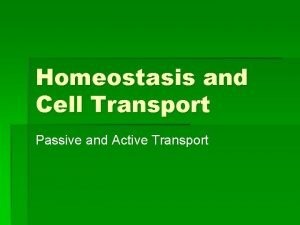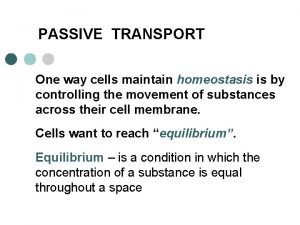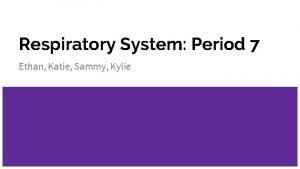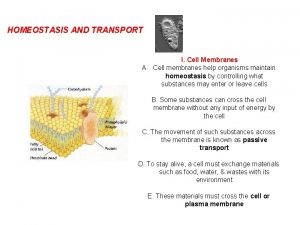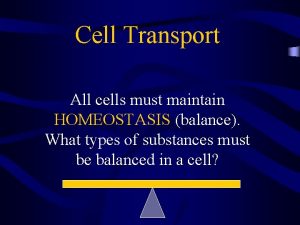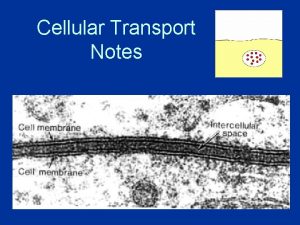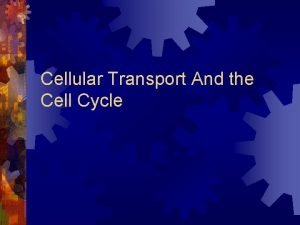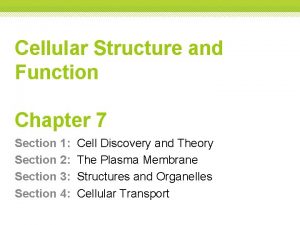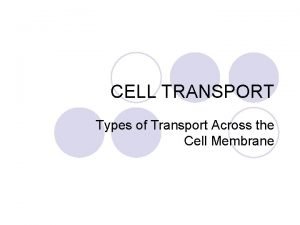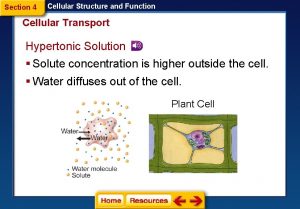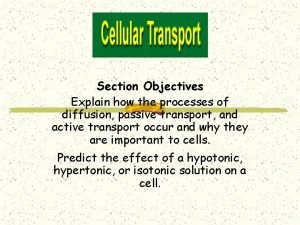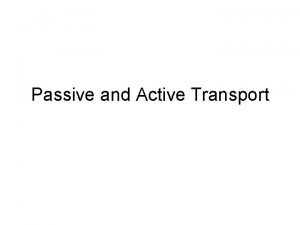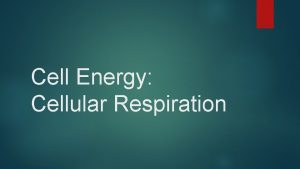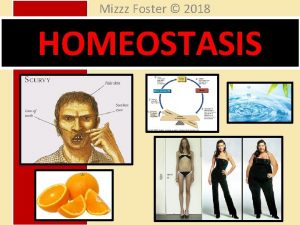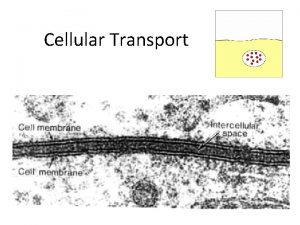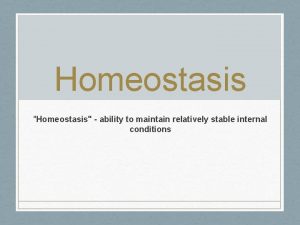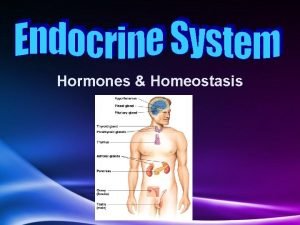Cellular Transport Its how we maintain homeostasis under
























- Slides: 24

Cellular Transport Its how we maintain homeostasis under a microscope salt viewed

Objectives 1. Explain how equilibrium is established as a result of diffusion 2. Distinguish between osmosis and diffusion. 3. Explain how substances cross the cell membrane through facilitated diffusion. 4. Explain how Ion channels assist the diffusion of ions across the memb.

1. Toward what condition does diffusion eventually lead in the absence of other influences? Eerie, dramatic pictures from the Hubble telescope show newborn stars emerging from "eggs“, compact pockets of interstellar gas called evaporating gaseous globules). Hubble found the "EGGs, " appropriately enough, in the Eagle nebula, a nearby star-forming region 7, 000 lightyears from Earth in the constellation Serpens. These striking pictures resolve the EGGs at the tip of finger-like features protruding from monstrous columns of cold gas and dust in the Eagle Nebula (also called M 16). The columns — dubbed "elephant trunks" — protrude from the wall of a vast cloud of molecular hydrogen, like stalagmites rising above the floor of a cavern. Inside the gaseous towers, which are light-years long, the interstellar gas is dense enough to collapse under its own weight, forming young stars that continue to grow as they accumulate more and more mass from their surroundings.

what condition does diffusion eventually lead toward in the absence of other influences? -Equilibrium, which occurs when the concentration of molecules is the same throughout a space. Incidentally all of the universe will eventually reach equilibrium

2. How is osmosis related to diffusion? -Diffusion: the movement of molecules from areas of high to low concentration -Osmosis: the diffusion of water across a membrane

3. If the concentration of solute molecules outside a cell is lower than the concentration in the cytosol, is the external solution Hypotonic, hypertonic, or isotonic to the cytosol?

Hypotonic

4. What role do carrier proteins play in facilitated transport? n LONDON, England (Reuters) -- The secret of carrier pigeons' uncanny ability to find their way home has been discovered by British scientists: The feathered navigators follow the roads just like we do.

4. What role do carrier proteins play in facilitated transport? n - They bind to specific substances on one side of the cell membrane, change shape and release the substances on the other side. They take things from outside to inside the cell.

5. How is facilitated diffusion similar to diffusion through ion channels? -Both help specific substances move down their concentration gradient from one side of the cell membrane to the other, without an input of energy by cells. Both also involve membrane proteins.

6. Sea water has a higher concentration of solutes than do human body cells. Why might drinking large amounts of sea water be dangerous to humans? - The solutes in the sea water would make the solution outside the body cells more concentrated. Water would then diffuse out of the cells, causing them to shrink and die.

Osmoregulation for fish n How do fish deal with the different tonicity between salt and fresh water?

n Freshwater fish face two problems: 1) getting rid of excess water and 2) maintaining proper salt content in their bodies. Their bodies need to maintain a higher level of salt than the surrounding water. As H 2 O passes in through their gill, Na+ is lost. To counter act this problem, freshwater fish drink constantly to maintain proper ionic levels. These ions obtained from drinking are transferred to the blood through the kidney via the "Bowman's capsule". Ions obtained through osmosis at the gill have a direct link to the blood via specialized "Chloride cells" in the gill. The efficient kidney enables the fish to excrete H 2 O very rapidly as a dilute urine. Na+ loss is greatly reduced by efficient reabsorption from the urine before it is excreted.

The Nile Perch is the largest fresh water fish available to anglers!!

Marine fish experience just the opposite effect because their internal salt content is less than that of the surrounding water. They loose water by osmosis and gain salts by diffusion. The effect is also worsened by a more permeable membrane. Marine fish also drink large amounts of water but their kidney functions differently. They pass small amounts of very dilute urine. Between 7 to 35% of their body weight is drank each day. Most of the H 2 O is retained to counteract the H 2 O lost via osmosis at the gill. Marine fish produce a daily urine amount about 1/10 to 1/20 of freshwater fishes. Terrestrial vertebrates produce approximately 1. 5% of their total body weight in urine daily. Freshwater fish produce 20% daily! As you can see, marine fish pass considerably less urine than freshwater fishes.

Active Transport Objectives: 1. Distinguish between active and passive transport 2. Explain how the sodium-potassium pump operates 3. Compare and contrast endocytosis and exocytosis

1. Explain the difference between active and passive transport Passive transport: Moves molecules down their concentration gradient, from areas of high concentration to low concentration. It does not require energy from the cell. n Active transport: Moves molecules up their concentration gradient, from areas of low concentration to high concentration. It does require energy from the cell. n


2. What function do carrier proteins perform in active transport? - They bind to specific molecules on one side of the cell membrane and transport the molecules up their concentration gradient to the other side of the membrane

3. What provides the energy that drives the sodium potassium pump? n - The removal of a phosphate group from ATP supplies the energy

4. Explain the difference between pinocytosis and phagocytosis -Pinocytosis: transport of solutes or fluids into cells -Phagocytosis: the movement of large particles into cells

Amoeba showing pinocytosis

5. Describe the steps involved in exocytosis. - During exocytosis cytoplasmic vesicles fuse with the cell membrane and release their contents outside the cell

6. During intense exercise potassium tends to accumulate in the fluid surrounding muscle cells. What membrane protein helps muscle cells counteract this tendency? Explain - The sodiumpotassium pump does this by transporting potassium into the cells in exchange for sodium.
 How does diffusion help maintain homeostasis
How does diffusion help maintain homeostasis One way cells maintain homeostasis is by controlling
One way cells maintain homeostasis is by controlling Section 5-2 review active transport
Section 5-2 review active transport Kylie knh
Kylie knh How do cells maintain homeostasis
How do cells maintain homeostasis What do unicellular organisms do to maintain homeostasis
What do unicellular organisms do to maintain homeostasis Bioflix activity homeostasis low blood glucose
Bioflix activity homeostasis low blood glucose Bioflix activity homeostasis hormones and homeostasis
Bioflix activity homeostasis hormones and homeostasis Homeostasis and cell transport
Homeostasis and cell transport Electron transport chain cellular respiration
Electron transport chain cellular respiration Cellular transport interactive animation
Cellular transport interactive animation Cellular transport and the cell cycle
Cellular transport and the cell cycle Chapter 7 section 1 cell discovery and theory
Chapter 7 section 1 cell discovery and theory Cellular transport foldable
Cellular transport foldable Types of cellular transport
Types of cellular transport Receptor - mediated endocytosis
Receptor - mediated endocytosis Cellular transport
Cellular transport Section 4 cellular transport
Section 4 cellular transport Section 4 cellular transport answer key
Section 4 cellular transport answer key Isotonic solution
Isotonic solution Practice types of cellular transport
Practice types of cellular transport Electron transport chain cellular respiration
Electron transport chain cellular respiration Bioflix activity membrane transport active transport
Bioflix activity membrane transport active transport Active transport vs passive transport venn diagram
Active transport vs passive transport venn diagram What is passive transport
What is passive transport
